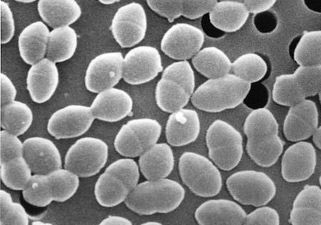Model organism for contamination
Another way to measure water quality is to look at what’s living in the water. You could count fish or oysters or insects. For example, one famous measure is to find out how many stoneflies, mayflies, and caddisflies are living in a stream—all insects that require cold clean water, and all gourmet food for the kinds of fish that anglers like to go after. But in this module, we’re going to do something a little different.
 We’re going to talk about measuring an undesirable organism that we can’t see. The organism is called Enterococci faecalis, or E. faecalis, and it is a spherical bacteria that primarily lives in the guts of vertebrates, where it does no harm and may actually help us to digest food. It can be ... um ... excreted from the body and from there it can get washed into the water.
We’re going to talk about measuring an undesirable organism that we can’t see. The organism is called Enterococci faecalis, or E. faecalis, and it is a spherical bacteria that primarily lives in the guts of vertebrates, where it does no harm and may actually help us to digest food. It can be ... um ... excreted from the body and from there it can get washed into the water.
 Humans generally use a sewer system to do their excretion, but most other animals don’t. A dog-walking park next to the creek could result in a creek full of enterococci, unless the dog-walkers are very good with their pooper-scoopers. So can a cow pasture, a chicken house, or a pig farm. But once the enterococci get into the water, they generally can’t reproduce very well. Instead, they just sit there, usually not causing any problems for anyone, but also being a great way to determine how much pollution is in the water.
Humans generally use a sewer system to do their excretion, but most other animals don’t. A dog-walking park next to the creek could result in a creek full of enterococci, unless the dog-walkers are very good with their pooper-scoopers. So can a cow pasture, a chicken house, or a pig farm. But once the enterococci get into the water, they generally can’t reproduce very well. Instead, they just sit there, usually not causing any problems for anyone, but also being a great way to determine how much pollution is in the water.
In order to use Enterococci as an indicator, we need to filter them out of the water, provide them with really good growing conditions, and see how many little colonies form after a day. Each colony will be visible to the human eye, and each one started from a single bacteria, so counting the colonies will allow us to estimate how many bacteria were present in the water to start with.
Copyright University of Maryland, 2007
You may link to this site for educational purposes.
Please do not copy without permission
requests/questions/feedback email: mathbench@umd.edu